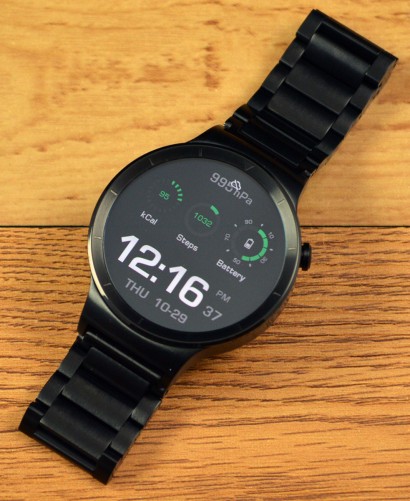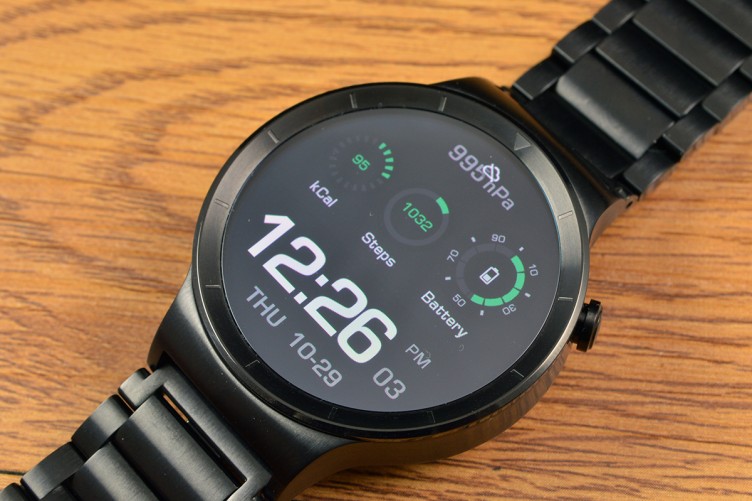QUICK TAKE
The Huawei Watch looks great and has a superb display. It's missing some features, though, and Android Wear is still too limited.
Smartwatches basically suffer the same fundamental limitations across the board, especially Android Wear devices. There is not much more the most expensive Android Wear watch can do that the cheapest cannot thanks to Google’s wearable OS. This leaves smartwatch makers with only hardware options for differentiation, which Huawei took to the heart with its latest, the Huawei Watch.
Smartwatches basically suffer the same fundamental limitations across the board, especially Android Wear devices. There is not much more the most expensive Android Wear watch can do that the cheapest cannot thanks to Google’s wearable OS. This leaves smartwatch makers with only hardware options for differentiation, which Huawei took to the heart with its latest, the Huawei Watch.
“Inspired by the classic design of luxury watches,” the Huawei Watch is built for “smart, stylish people,” according to the company. Its price tag, ranging from $350 to $800, matches this pitch, as the Huawei Watch is one of the more expensive Android Wear watches available.
Huawei hopes this focus on quality watch hardware will be enough to pull potential buyers away from competing devices, including the LG Watch Urbane, which is going after the same upscale demographic.
Is it enough? Read on to find out.
Build & Design
This is a well-built watch. We’ve dinged Huawei in the past for its wearable design choices, but there is nothing to complain about here. The 42mm watch face consists of cold-forged 316L stainless steel, and juts out about 11.3mm from the wrist. It feels solid, and a bit heavier than expected, which suggests a quality build.
Our review unit felt great when worn, both well balanced and snug. To be fair, we tested the black stainless steel link band, and can’t speak to the comfort of the steel mesh or leather bands. Given those are typically the more comfortable than metal links with traditional watches, we’re confident that all Huawei Watch options wear well.
While it’s obvious Huawei is marketing the Huawei Watch to men, it’s still too bad it’s only available in this size. It’s large enough that we suggest anyone looking to buy try it on first.
The Huawei Watch sports a crown on the upper-left side of its round display, which only functions as a button, toggling the display and apps/settings access. It presses well and serves its purpose.
It’s IP67 rated, meaning it can deal with dust and water splashes, and even an accidental submersion. Just to be safe, don’t take it in the shower or pool, but if you wear it while washing your hands or get caught in the rain, it will be fine.
The Huawei Watch charges via a magnetic sphere that attaches to the bottom. But unlike the Apple Watch charger, this one has four pins that align to receptacles on the back. Overall, it’s not a bad charger design, but it’s not as good as the Apple Watch or Moto 360, given the pins require specific placement.
Display
The Huawei Watch display is fully round, unlike theMoto 360 smartwatches that have the “flat tire” look owing to a small section on the display bottom. It’s a 1.4-inch full-circle AMOLED display with a 400 x 400 resolution, resulting in 286 pixels per inch.
It looks great and further proves AMOLED is the only smartwatch display tech worth conisdering. Colors pop, contrast is deep, and it’s sufficiently bright at the highest setting.
The display glass is sapphire crystal, making it extremely tough. That, coupled with a display bezel that slight extends above the watch, add a sense of security in knowing this watch face won’t nick or scratch easily.
Unfortunately, it’s also a reflective display, and here’s where the display praise ends. The Huawei Watch can be really hard to see outdoors in bright light. Max brightness offers a passable experience, but the Android smartwatch does not have an ambient light sensor to automatically adjust. Users have to manually boost the brightness in order to cut through any glare. Android Wear offers shortcuts to the setting, but it’s extremely difficult to access when you can’t see anything. There should be a voice command for this, but we couldn’t find one.
To be fair, this has been a constant problem with many smartwatches we’ve tested, and it’s illustrative of the limits. In fact, only high-end tablets and smartphones have been able to reasonably address glare.
Performance
The Huawei Watch has a 1.2GHz Qualcomm Snapdragon 400 processor, along with 512MB of RAM and 4GB of storage for apps and content. These do a fine job running Android Wear and keeps things swift and relatively responsive (we have yet to test a smartwatch that didn’t have some lag).
Sensors include a gyroscope, accelerometer, hear rate, and barometer. Barometer is an odd choice, and there is not much use for it. Some watch faces include the atmospheric pressure information, but what are you supposed to do with that?
Voice dictation works great and is accurate, which is key for any wearable. The heart rate monitor and steps counter measurements are consistent with other activity trackers, though the Huawei Watch is not a good fitness device. It’s too big, and the bands don’t lend themselves to exercise.
There is no GPS, which is a curious omission for an expensive smartwatch. It’s not a deal breaker as the Android Wear smartwatches that have it don’t do much with it independent of an Android phone (which will have GPS), but if we are buying one of the more expensive Android smartwatches, we want it to have everything.
The Huawei smartwatch supports Bluetooth 4.1 and Wi-Fi, though not in the way you might think. The Watch, like other Android Wear wearables, can connect to 2.4GHz networks, but only through a smartphone and the Android Wear app, and only on networks that don’t require a separate login, like hotel or secure corporate Wi-Fi. The Huawei Watch cannot connect independently. Once connected, the Huawei Watch loses its Bluetooth tether. So long as the smartwatch and Android smartphone are connected to a network (the 2.4GHz network for the Huawei Watch, and any network — Wi-Fi or otherwise — for the smartphone), the Huawei Watch will retain all its functionality. This works great when you’re wearing it at home, but it’s far from the killer feature “Wi-Fi support” suggests.
Like other Android Wear smartwatches, the Huawei Watch can store downloaded Google Music tracks for offline playing. This requires Bluetooth headphones, and the process of loading songs onto the watch is slow and cumbersome. But it works, and it’s a genuinely useful feature.
Android Wear
In the year and a half since Google launched it, Android Wear has gone from limited but promising to, well, limited but promising.
At its core is Google’s desire to proactively deliver necessary and contextual information to the Android smartwatch wearer, be it an email, message, traffic info, weather alert, or whatever, ultimately saving the wearer the “hassle” of whipping out a phone and staring the display.
We can buy into that, but the problem is that the alerts are delivered through Google Now, which hasn’t proven reliable enough in delivering the information users need.
In regards to Android Wear, yes, it pushes out the occasional traffic delay and calendar alerts, but it also randomly delivers all kinds of things it thinks we like, like sports scores and stock prices. Sure, we like to know how our parent company is doing on the NASDAQ, but we don’t need TechTarget’s stock price delivered throughout the day.
This can all be managed easily enough through a Google account, but it requires upkeep, and Google is quick to think users are interested in something because they Google it a few times or visit a website periodically.
To top it all off, Google Now is just not reliable. We hit traffic many times during testing, but rarely did Android Wear warn us in advance. We experienced the first morning frost of the season without any kind of alert. Shouldn’t Google push that information out knowing we live in the northeast, where many AC units still rest in windows and plants sit on porches outdoors?
It’s also still buggy. We couldn’t turn off wrist gestures (display powers on when watch is rotated, under the assumption the user is looking at it), which are annoying at best. This could be a hardware issue, but given our experience with other Android Wear devices, we blame the software.
Google Maps navigation, an Android Wear strength, also doesn’t fare so well on the Huawei Watch. Other Android wearables will vibrate to alert upcoming turns (great for motorcyclists and bicyclists), but this watch did not. The Huawei Watch vibrates for other alerts, so we suspect a future software fix should/will address this.
Many have also complained about the lack of Android Wear apps. Last May, just short of a year on the market, Google claimed there were 4,000 Android Wear apps. Three months after launch, the Apple Watch had 8,500.
We’d complain as well, if we knew of any must-have smartwatch apps. It would be befuddling that no third-party apps have shown the potential of smartwatches as mass-market devices, but we think that’s overstated. Smartwatches will ultimately succeed not as scaled back smartphones worn on the wrist enabled by apps, but rather central to the Internet of Things. Smartwatches should serve to open smartlocks, start smart cars, check in at smart restaurants and hotels, make mobile payments, and generally facilitate everyday task automation.
But that’s looking forward and we digress. There are still some things that Android Wear does very well, like Google’s own apps. As we mentioned, messaging is great, Sending emojis is particularly fun as Android Wear lets users scribble a drawing, which Android Wear then matches to available icons. Setting reminders and appointments is a breeze, and travelers will get plenty of use out of Google Translate. We also like having access to info on our wrists, like “when is daylight saving’s time,” and answers to basic math problems.
iOS Compatibility
The Huawei Watch is one of the few Android Wear watches (as of this writing) that work with the iPhone 5 or newer running at least iOS 8.2. Given iOS is a generally closed system, this seems like a major coup, but the experience is so limited it serves more as a curiosity than anything else. Some Google apps, like Google Now and Gmail, work exactly as they would when paired with an Android smartphone, but just everything else is stuck sending notifications with little to no interaction.
As long as Apple is selling the Apple Watch, this won’t change. There is no reason for iPhone owners to buy any Android Wear smartwatch over Apple’s own.
Battery
The Huawei Watch has a 300 mAh battery, which Huawei claims is good for up to two days of power. We found that to be accurate in testing, provided the display is kept at medium brightness. Of course, smartwatch battery life can vary greater than just about any product depending on usage.
It also charges fast, going from near dead to full in little more than an hour.





